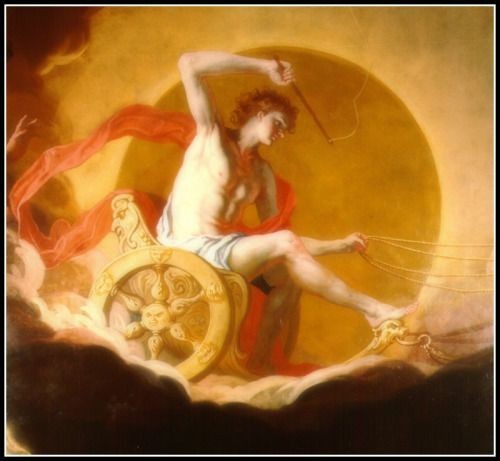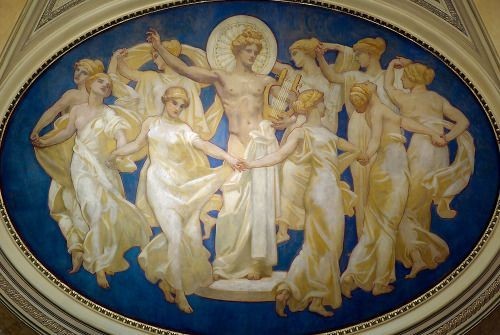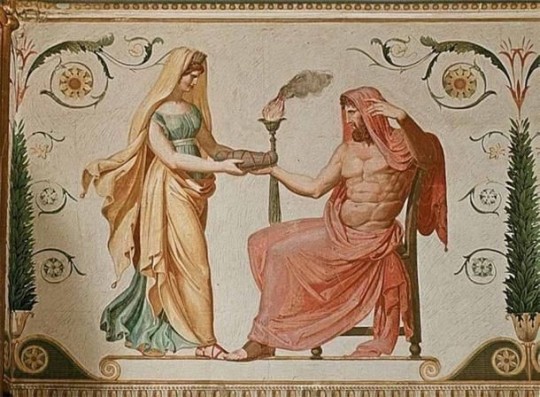#Greek calendar
Explore tagged Tumblr posts
Text

Title: Christ Pantokrator (Ruler of All) Artist: Elias Moskos (Greek [Cretan], 1629-1687) Date: 1653 Genre: religious art; icon Movement: Cretan School Medium: egg tempera on wood Dimensions: 119 cm (46.8 in) high x 85 cm (33.4 in) wide Location: Icon Museum Recklinghausen, Germany
#art#art history#Elias Moskos#religious art#Christian art#Christianity#Eastern Orthodox#Orthodox Christianity#Christ Pantokrator#Christ the King#Christ the King Sunday#liturgical calendar#Cretan School#Greek art#Cretan art#17th century art#icon#icons#egg tempera on wood#Icon Museum Recklinghausen
157 notes
·
View notes
Text

In today's 9 door, we delve into the world of greek mythology. We sail with the Penteconter Argo in search of the Golden Fleece.


The Argo is a replica of the legendary ship on which Jason and his Argonauts braved fearsome creatures and other dangers in their search for the Golden Fleece. The replica ship set sail from Jason's home town of Volos in central Greece on 14 June 2008, propelled by 50 oarsmen. On its 2,000 nautical miles (just over 3,700 kilometres) journey, which ends in the Italian port of Venice on 11 August, the ship will drop anchor in a total of 23 cities. An original plan for the Argo to sail to the Black Sea region like its ancient namesake was scrapped after Turkey refused to guarantee the ship safe passage through the Bosporus.
Today she lies ashore, waiting to be placed in a museum.
106 notes
·
View notes
Text



🌿🏺My 2024 Saturnalia Shop is live! 🏺🌿
I am stocking favourites from last year, like my Epic Trilogy Bookmarks and foiled Roman Gods stickers, as well as 2025 calendars, two new A5 notepads, and a new Saturnalia card design! 🧡
Shop link: shop.flarohillustration.com
#tagamemnon#flaroh illustration#greek mythology#ancient greece#hellenic pagan#greek myth art#argh sorry I’ve been awful at keeping my tumblr up to date#stationary#wlw#for the calendars lol#college#university#illustration
61 notes
·
View notes
Photo

rough concept doodles for my latest au musings (which will hopefully have a fic. im gonna try.). current title for it is “RETCON”
au premise: the gang becomes self-aware of how messed up their timeline is and seeks out the help of Chronos, primordial god of time, to set things right. The characters working with Chronos get a mark of some kind on them from him, everybody else is out of the loop and having A Time, probably.
the entire thing is ridiculously meta it’s fun.
#pjo#percy jackson#luke castellan#nico di angelo#thalia grace#jason grace#will solace#< not the whole cast but just who i had the most immediate ideas for symbols to doodle#sans Will he's just having a rough time#all the symbols are time/clock-related of course#Percy's is a greek zodiac calendar (centered on leo of course cause thats his zodiac)#Jason's is a sundial on his chest#Thalia's is a clock and Luke's is clock hands#and Nico's is just a clock gear#my art#au#symbols are subject to change but this is mostly just self-reference doodles#and ironing out ideas#im gonna be unable to draw for like two weeks so im prob gonna go ham writing for that time#this au is super fun to me though cause i get to go absolutely wild and funky with it#it makes literally every retcon and inconsistency simultaneously canon which is why the gang has to fix it#which means i get to make the wonkiest timeline ever#which is SUPER fun for me. my analysis brain is going brrr#also yes im sticking Luke in this au for no reason. he's a fun character and this au makes no sense so ergo it makes sense hes here#RETCON au
466 notes
·
View notes
Text
valgrace bday week

#who dosent have fictional ppls bdays in their calendars anyway!!#julys first week starts with jasons birthday and ends with leos#and the following friday is annabeth’s birthday!!!#honestly i love valgrace so much platonically#ᝰ fay [ft. voices in head] .ᐟ#pjo#pjo hoo toa#hoo#heroes of olympus#leo valdez#jason grace#annabeth chase#percy jackson#perseus jackson#rick riordan#percy jackson and the olympians#ancient greek mythology#the heroes of olympus#trials of apollo#the trials of apollo#rrverse#riordanverse#rick riordan universe#chb#cj#camp half blood#camp half-blood#camp jupiter#july#calendar
69 notes
·
View notes
Text
Thank you Lady Athena for your help once again this semester 😭🙏🏻 got 2 A- & a B+
#athena devotion#athenian calendar#athena worship#athena greek mythology#hellenic polytheism#hellenism#hellenic pagan#hellenic deities#hellenic paganism#hellenic gods#helpol#hellenic worship#witchcraft#hellenic polytheist
23 notes
·
View notes
Text
Calendar manipulation in Ancient Greece
This really isn’t a topic I’m thrilled to tackle, but since the Theogamia there has been so much talk about calendar discrepancies that it looks like the right time to bring this up. Don’t expect this to be eloquent, I’m writing this while absolutely knackered.
I’m not going to focus too much on the problem of modern calendar reconstructions, what I’ll be going into here is the historical evidence we have about how awfully inconsistent the ancient Athenian calendar could be, either by nature or by human intervention over time.
The problem of the new moon
In theory, the Athenian calendar and other Greek calendars are lunar and each month begins on the new moon. Sacha Stern, in Calendars in Antiquity, tells us that the writer Geminus (1st c. BCE), states that the Greek month began when the new moon crescent was first sighted but Geminus also states that the new moon can sometimes be sighted on the 1st of the month, but sometimes not until the 3rd. This statement is interesting, because it implies that, should the moon not be visible (clouds), there was a mathematical basis to the calculation of the months that still made the month begin regardless of what the sky looked like.
There comes also the problem of conjunction (aka when the moon in orbit passes between the sun and the earth, making the moon invisible). The traditional ancient assumption is that the day of conjunction is the last day of the month. However, the interval between the day of conjunction and of the new moon is usually around two days; so if the month began when the new moon was first sighted, conjunction should have been typically on the penultimate day of the previous month.
Those difficulties, along the fact that other authors, such as Aratus give conflicting information leads Stern to say this:
Modern scholars have generally accepted Geminus’ statements that the Greek month began at first visibility of the new moon. However, it is clear on Geminus’ own evidence, as well as on the evidence of the other passages just mentioned, that this rule was not strictly followed, and indeed, quite possibly, that it did not constitute a rule. Moreover, we do not know of any procedure that may have been used, and indeed that would have been necessary, for such a rule to be enforced. There is no evidence, for example, in the whole of Graeco-Roman literature of anyone sighting the new moon.
And this leads us to the rather uncomfortable idea that, in practice, a lot of the calendars simply might not have been as well aligned with astronomical moon phases in the way we conceptualize it today.
Francis M. Dunn, in an article titled Tampering with the Calendar, lists passages from ancient Greek sources that seem to corroborate this idea:
Thucydides 2.28 in a passing mention of a solar eclipse […] distinguishes the astronomical "new moon" or conjunction, at which eclipses must occur, from the conventional "new moon" or noumenia, which followed the first visible crescent. The historian, in other words, is aware that there is an astronomical "new moon" or conjunction which is different from the first day of the civic month.
Man-made adjustments
Because calendars impacted the religious, civic and political lives of each city-states, it wasn’t uncommon for city-states to make adjustments to them.
The type of modification we’re most used to is the addition of intercalary days or month that aim to realign the calendar with astronomical reality. But we have evidence that this isn’t the only motivation.
For example:
In the 430's (SEG XXXVI 12), 420's (SEG XL 12) or 410's (SEG XLII 17), in connection with offerings at Eleusis, the demos instructed the archon to add a second Hekatombaion.
In 228/7 a second Hekatombaion was added to the civic calendar.
Between 294 and 288, in connection with a tour by artists of Dionysus during Lenaion, four cities in Euboea made provision for the archons to add months as necessary.
At the end of the fourth century, probably in 307/6, two days were apparently added near the end of Gamelion.
In 271/0 four days were added in the first decade of Elaphebolion.
As we can see, additions and subtractions of one or several days, if not sometimes months, could happen. They were often added either at the beginning of a month or at the end of a month, which makes it easier to imagine that it could be done to readjust the calendar to the moon, but in the cases where it was linked to a festival, it was clearly done to schedule said festival:
”Of the three cases of intercalary months, two are explicitly related to religious festivals (the dedication of first fruits at Eleusis, IG I3 78; and dramatic festivals in Euboea, IG xii.9 207”
“The evidence therefore supports an assumption that most adjustments were part of the normal operation of the civic calendar - ensuring that the calendar was roughly in phase with sun and moon, and ensuring that festivals would take place at a necessary or convenient time.”
An insoluble debate
The problem of ancient Greek calendars as a whole has been a point of contention among scholars for so long, for the simple reason that it makes dating anything difficult. The most notable example is the one around the differences between the Athenian calendar and the Spartan one when it comes to dating something like the battle of Marathon. Plutarch tells us it was on the 6th of Boedromion, but Herodotus tells us it was during the full moon (and therefore later, if the calendars matched the lunar cycle). This is where the issue of inter-city calendar alignment emerges, since each city-state functioned in their own independent ways, they could resort to calendar adjustments at any time they wanted and further misaligning themselves with one another.
But scholars don’t necessarily agree! Some, like Pritchett believed that the calendars were irregular no matter what, while others like Meritt believed they were regular, and that the evidence of irregularity was due to exceptional circumstances. The problem at this point is that it is much harder to prove regularity than the opposite.
So where does it leave us?
The reconstructed calendars we use today as modern worshippers are all based on some form of regularity, but we need to remember that none of them are a direct continuation of the ancient calendars. For the most part, they are based on the metonic cycle and on the other luni-solar calendars in use today by various faiths and cultures around the world. In fact, a lot of the reconstructions of Athenian calendars are using the same mathematical model as the Hebrew calendar. And that, in a nutshell, explains why different reconstruction have different results when it comes to placing specific days and festivals. So it really comes down to personal choice. Choosing a calendar that is more “popular” might be more appealing to you for particular reasons, while others might choose their calendar based on entirely different criteria. I guess the point I’m trying to get to is that, there won’t be a “standard” calendar without some kind of wide decision to stick to a precise model, and as long as there is no religious authority, the calendars will remain ever so slightly different, because they never really were regular in the way that we understand our solar Gregorian calendar to be.
91 notes
·
View notes
Text



9 Metageitniōn| Μεταγειτνιών (Attic Calendar) - 14th of August/ 20th-24th of August
Helios (Ἡλιος), The Muses (Μουσαι) and Rhea (Ρεια, Μητηρ Θεων)
The Muses are: Melpomene the Muse of tragedy held a tragic mask, Thaleia Muse of comedy a comedy mask, Terpiskhore Muse of dance a lyre, Kalliope the Muse of epic poetry a lyre, Kleio the Muse of history a stylus and scroll, Polymnia the Muse of hymns a veil and pensive pose, Ourania the Muse of astronomy a globe, Erato the Muse of erotic poetry a lyre, and Euterpe the Muse of lyric poetry a flute.
Hesiod, Theogony 1 ff (trans. Evelyn-White) (Greek epic C8th or 7th B.C.) :
"Of the Mousai Helikoniades (of Helikon) let us begin to sing, who hold the great and holy mount of Helikon, and dance on soft feet about the deep-blue spring and the altar of the almighty Kronion [Zeus], and, when they have washed their tender bodies in Permessos [stream of Helikon] or in the Hippokrene (Horse's Spring) or Olmeios [stream of Helikon], make their fair, lovely dances upon highest Helikon and move with vigorous feet"

Rhea, Mater Megala
Antoninus Liberalis, Metamorphoses 19 (trans. Celoria) (Greek mythographer C2nd A.D.) :
"In Krete there is said to be a sacred cave full of bees. In it, as storytellers say, Rhea gave birth to Zeus; it is a sacred place an no one is to go near it, whether god or mortal. At the appointed time each year a great blaze is seen to come out of the cave. Their story goes on to say that this happens whenever the blood from the birth of Zeus begins to boil up. The sacred bees that were the nurses of Zeus occupy this cave."

Ἡλιος
HELIOS (Helius) was the Titan god of the sun, a guardian of oaths, and the god of sight. He dwelt in a golden palace in the River Okeanos (Oceanus) at the far ends of the earth from which he emerged each dawn, crowned with the aureole of the sun, driving a chariot drawn by four winged steeds. When he reached the the land of the Hesperides in the far West he descended into a golden cup which bore him through the northern streams of Okeanos back to his rising place in the East.
Homeric Hymn 31 to Helius (trans. Evelyn-White) (Greek epic C7th - 4th B.C.) :
"Glowing Helios (Sun) whom mild-eyed Euryphaessa (Wide Shining), the far-shining one, bare to [Hyperion] the son of Gaia (Gaea, Earth) and starry Ouranos (Uranus, Heaven). For Hyperion wedded glorious Euryphaessa, his own sister, who bare him lovely children, rosy-armed Eos (the Dawn) and rich-tressed Selene (the Moon) and tireless Helios (Helius, the Sun) who is like the deathless gods."
#hellenistic#hellenic deities#hellenic pagan#hellenism#hellenic polytheism#hellenic worship#hellenic calendar#festivals#rhea#helios#the muses#deity#deity work#deity worship#pagan#paganism#paganblr#sources#greek#greek literature#greek deities#greek tumblr#greek mythology#greek gods#greek myth#greek myth art#greek posts#ancient greece#pagan witch#apollo
32 notes
·
View notes
Text
Advent Calendar, Underrated Artists Edition 8
Proserpina
Awesome and VERY underrated animatics of Epic The Musical! I love a lot their designs, expressions and the way they portray the actions of the characters.
https://youtu.be/NgjLvBF9VSs?si=gQQk8hdT_C4wm8Xi

See you tomorrow!
#advent calendar#underrated artist#artist promotion#epic the musical#artists on tumblr#artist boost#animator art#animatic#song of achilles#patroclus x achilles#achilles#patroclus#greek mythology#epic#epic the ocean saga#epic the troy saga#epic the ithaca saga
11 notes
·
View notes
Text

Kangela Tromokratisch photographed by Lefteris Koulonis x
#lgbt greece#greek tumblr#kangela tromokratisch#greek drag#drag queen#mrs potato head???#anyway buy her 2024 calendar
22 notes
·
View notes
Text




Hi! I would like to inform you all that we, a group of very talented Greek artists, created this 2024 catlendar! So, if you love cats and you need a cute calendar for this year, please consider supporting us! We have opened preorders for the physical calendars and we have also uploaded a digital, printable version of this catlendar for a lower price. You can find both of them at our ko-fi (https://ko-fi.com/tuttifruttiproject)!
Our group, the Tutti Frutti Project, aims at creating works through which we can bring the Greek artist community closer and support our artistic endeavors in these harsh conditions. Your support is incredibly important and we can't begin to thank you enough ❤️
#calendar#catlendar#cats#artists on tumblr#illustration#art#tutti frutti project#greek tumblr#greek artists#art project#angelic.txt#sunthief.png
30 notes
·
View notes
Text

Hey so I made an Alternative Advent Calendar in 2021 with Ancient Greek Mythical Creatures in it. I made some physical copies and then a PDF to download-and-print at home because postage/time.

She got one 😁

I’m making another one this year with Ancient Greek Mythical Women, so I’ve made a fantasy temple version based on the Tholos of Athene outside Delphi and the Tholos temple of Vesta in the House of the Vestals, Rome. I’ve literally be thinking about it for an entire year 😂

Here’s a sly peek at it (uncut).
Is it pretty? I really want it to be pretty.
The old one download-and-print: https://greekmythcomixshop.wordpress.com/2021/11/06/new-ancient-greek-mythological-creatures-advent-calendar/
Also one that you can print blank for classes to colour in: https://greekmythcomixshop.wordpress.com/2021/11/10/new-ancient-greek-colour-in-draw-your-own-mythological-creatures-advent-calendar-teachers-edition/
#alternative advent calendar#ancient Greek advent calendar#greek mythology#tagamemnon#greek myth#illustration#greek myth comix#comix#Ancient Greek mythical women#ancient greek mythology#advent calendar#download and print#teaching resources#classical civilisation#mythical creatures
20 notes
·
View notes
Text
varric grew up with a mother who was very othrodox so she didn’t do gifts during Hanukkah but it is fine to do small gifts, hand made or food, wine is acceptable, but gift giving is typically reserved for Purim and sometimes Passover and High Holy days, but all dependent on family and how one grew up
#.from the desk of: v. tethras ( headcanon )#Elisa what do you guys do#We do both I’m Jewish tepid doesn’t bother - my father grew up Catholic it’s weird ky is Greek Orthodox so I know that calendar too
6 notes
·
View notes
Text
playing around w hebcal date converter and confirming your calendrical* calculations is so much fun
#*ive mentioned before that a great feature of the english language is having fancy greek/latin-root words for adjective#versions of words/the study of things/generally facier; a great flaw is theres no such word for calendars#txt
6 notes
·
View notes
Text
Oh Happy Earth Day!
May Gaia & Uraš bring you happiness & peace 🌎
#maybe I'll manage a sink libation today#earth day#gaia#uraš#helpol#polytheism#greek deity#sumerian deity#calendar work
5 notes
·
View notes
Text

academia.edu you don’t understand i have read this article approximately one million times
#why are you as an academic writing about roman epic considering a trope from the greek epic cycle / tragedy#and not Also thinking about how Days Of Doom are v much a thing in the Roman calendar! potentially a more relevant context to a Roman#historical epic. hmmmmmmmmmmmm#beeps
33 notes
·
View notes